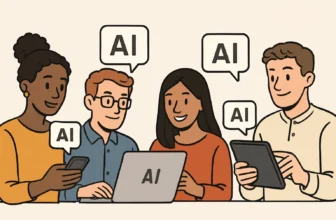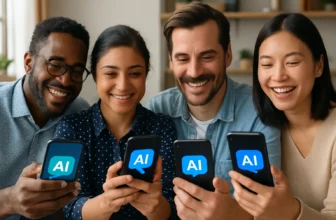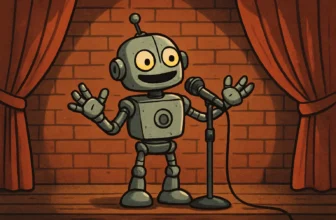
Unlocking the Future: AI in Education
Did you know that over 90% of students in recent global surveys said they’d be open to having AI help personalize their learning? That’s not sci-fi—it’s *right now*. Wild, right?
Okay, picture this. You’re signing into your favorite online course late at night, tea in hand and pajamas on (hey, been there!). Instead of a one-size-fits-all video, you’re met with content that speaks directly to how *you* learn best. Maybe it slows down when you need more time or offers quick summaries when you’re flying through the easy stuff. That’s AI in online learning, and it’s not only possible—it’s becoming the new norm.
Why does this matter? Because learning online isn’t always easy. We’ve all been there—zoning out halfway through a recorded lecture or rewatching a tutorial five times just to understand one concept. Everyone learns differently, and that’s where traditional e-learning strategies fall flat. Now toss in AI, and suddenly we’re talking tailored experiences, smart feedback, and more time saved. Yes, please!
So How Exactly Is AI Changing Online Learning?
- Personalized learning paths: AI can analyze how you interact with content and adjust your course journey based on performance, preferences, and pace. It’s like having a virtual tutor who *gets you*.
- Real-time feedback: No more waiting days for quiz results. AI can instantly point out where you stumbled, what to practice, or even offer extra materials. Fast and super helpful.
- 24/7 support bots: Stuck at 2 AM? AI-powered chatbots can answer common questions, guide you to resources, or even calm your pre-exam panic. (I’ve leaned on one of those bots more times than I care to admit…)
I had a friend, Sarah, who was struggling with math in an online program. After switching to an AI-powered platform, it immediately targeted her problem areas with interactive exercises—not generic ones—the exact ones she needed. Her confidence (and grades) went way up. It was like flipping a switch.
Where Do *You* Fit Into This Brave New World?
If you’re a student, start exploring platforms that integrate e-learning AI tech—many offer free trials. Notice how much difference a tailored experience makes. And educators? This is your cue to embrace the tools that free you up for real connection, while AI handles the data and customization.
The takeaway: AI in education isn’t about replacing humans—it’s about enhancing how we learn and teach. We’re not handing over the classroom keys to robots. We’re using them to unlock better ways to learn. Honestly, it’s kind of exciting, isn’t it?
So go ahead—lean into it. The future of learning is already here… and it’s got your name written all over it.
Personalized Learning with AI
Did you know that nearly 70% of online learners drop out because they feel disconnected or overwhelmed? Wild, right? It’s like walking into a massive lecture hall, sitting in the back row, and realizing no one even notices you’re there. You nod along, but deep down, you’re thinking, “Am I even getting this?” Yeah… been there.
One of the biggest gripes with online learning is that all-too-familiar one-size-fits-all approach. Everyone gets the same readings, the same assessments, the same feedback—whether you’re zooming through like a pro or just trying to make sense of the basics. And let’s be real, it can feel pretty isolating.
But here’s where the magic of AI swoops in like a superhero with a bag of personalized goodies.
How AI Makes Learning Feel Like It’s Made Just for You
AI-driven tools are completely transforming online education by adapting content in real-time based on how you learn best. It’s like having a private tutor who actually knows your quirks—and doesn’t judge you for reviewing the same concept four times (we’ve all been there!).
- Adaptive Learning Paths: AI can track your progress and tweak your path as you go. Struggling with a concept? It’ll slow down and offer practice or even switch up how it teaches—think videos instead of text or interactive examples.
- Smart Feedback: Gone are the days of vague “Good job” comments. AI-based platforms give detailed insights: where you went wrong, how to improve, and exactly what to focus on next time.
- Personalized Study Schedules: Tools like Coursera’s Smart Planner or Khan Academy’s mastery system use AI to space out your study time based on what you’ve mastered and what still needs love.
Real Talk: It’s Working
I’ve seen it firsthand. My cousin Lily—bless her, she used to dread her online algebra class—started using an AI-powered platform. At first, she just wanted to survive the course. But after a few weeks? Total transformation. The AI adjusted the lessons based on her weak spots, and she actually started *enjoying* it. She finished the semester with an A. She still brags about it at family dinners.
And it’s not just Lily. A Stanford study found that students using AI-personalized content saw a 20% improvement in retention and test scores compared to traditional online classes. That’s not just helpful—that’s game-changing.
Where Do You Start?
If you’re feeling a little stuck or invisible in your course, try experimenting with AI-powered tools. Platforms like Quizlet’s Learn Mode, Duolingo’s Smart Review, or Socratic by Google offer personalized support that adapts as you grow. Kind of like having your own educational GPS. 🚀
Here’s your takeaway: You don’t have to figure it all out alone. With AI-powered personalization, online learning can finally feel like it’s made just for *you*. No more one-size-fits-all. It’s time for one-size-fits-YOU.
Stick with it. Lean into the tech. And remember—progress doesn’t have to look perfect, it just has to be yours.
AI Platforms Empowering Educators
Can you believe the average teacher spends nearly 50% of their workweek on non-teaching duties? Yep, that’s grading, scheduling, emails, lesson planning—you name it. And let’s be honest, none of us got into education for the admin work, right?
Teachers and educators, I feel you. You probably signed up to spark “aha!” moments, to make eye contact with a student who finally *gets it*, and to create those magical classroom vibes—even if your classroom is now more pixel than chalkboard. But the real buzzkill? Feeling buried in busywork with barely enough energy left to do the part you love most: actually teaching.
The Reality: Admin Overload is Real
I remember chatting with my friend Sara, a high school English teacher turned online instructor. She told me that after switching to virtual teaching, she thought she’d gain flexibility. Instead, she was drowning in making digital lesson plans, manually tracking attendance, and answering emails at midnight. Yikes.
But here’s the twist—AI is finally stepping up as the digital assistant she (and you!) never knew you needed. And no, we’re not talking about robot teachers replacing humans. We’re talking about smart support systems that do the heavy lifting so you can focus on connecting with students.
How AI Is Actually Helping (Not Replacing) Teachers
Here’s the good news: educators are already using AI-powered platforms to reclaim their time and sanity. Let me show you how:
- Grading Assistants: Platforms like Gradescope use AI to help reduce the time spent grading open-ended responses. Feedback is faster, more consistent, and less mind-numbing. Win-win.
- Smart Lesson Planning: Tools like Khanmigo from Khan Academy and Curipod generate lesson ideas, discussion questions, and even interactive slides—based on your topic and age group. It’s like having a super creative co-teacher on-demand.
- Personalized Learning Insights: With platforms like Century Tech or DreamBox Learning, you get real-time dashboards showing which students are stuck and who’s ready for a challenge. So much better than guesswork, right?
Real Teacher, Real Results
Sara (remember her?) started using Curipod and Gradescope in her hybrid classroom. Within a month, she cut her grading time in half and spent that extra time running small group sessions online—where she noticed engagement jump because she could actually *be present.* She told me, “It feels like I get to teach again, not just work around teaching.”
Looking Ahead: Teaching Just Got a Tech Boost
So if AI has you picturing robots in suits lecturing students, pause for a moment. The real magic is in how these tools work with you, not instead of you. They help you focus on the moments that matter—the connections, the breakthroughs, the joy of seeing your students thrive.
Here’s your takeaway: Don’t be afraid to try one new AI tool this month. Just one. Maybe it’s automating quizzes, or getting help crafting a lesson. See how it feels. Odds are, you’ll wonder how you taught without it.
Because the future of education isn’t teacher vs. tech—it’s teacher + tech = more time, more impact, and a whole lot less stress.
Breaking Barriers: AI for Accessibility
Did you know that over 1 billion people worldwide live with some form of disability? That’s one in eight of us — and when it comes to learning, traditional systems too often leave these students behind. But here’s the exciting part: AI is finally flipping the script, making education genuinely inclusive for everyone.
I remember chatting with a friend of mine, Maria, who teaches English online. One of her students, Ethan, has dyslexia. In a physical classroom, he constantly felt behind—embarrassed to read aloud, frustrated by the pace. But online, with the help of AI-driven tools like text-to-speech and real-time captioning, his world opened up. He didn’t just keep up—he started thriving.
So, what’s the challenge?
Even in the digital age, many students with disabilities or learning challenges hit roadblocks. Maybe it’s not being able to see the screen well, hear the lecture clearly, or process information as fast as it’s delivered. And this isn’t just frustrating—it can be heartbreaking. Imagine being hungry to learn, but always feeling a few steps behind the rest of the class.
But here’s where AI steps in like a superhero with a laptop.
AI Solutions That Make Learning Inclusive
Want to know how AI is removing those barriers? Let’s break it down into some real, helpful tools:
- Text-to-Speech & Speech-to-Text: These aren’t new, but with AI, the accuracy and naturalness have skyrocketed. Students with dyslexia, visual impairments, or mobility issues can either listen instead of reading or speak instead of typing.
- Real-Time Captioning & Translation: Platforms like Zoom or Microsoft Teams are using AI to generate live subtitles in multiple languages—a game-changer for deaf students or those learning English as a second language.
- Adaptive Learning Platforms: Tools like DreamBox and Coursera’s AI tutors personalize the pace, language complexity, and delivery format to match how a student best learns. It’s like having a custom-made teacher in your backpack.
And for educators? These tools make it less stressful to meet every student’s needs. You’re not rewriting your entire lesson plan—you’re just enhancing it with tools that do the heavy lifting for you.
What You Can Do Today
If you’re a student, start exploring what tools are already available in your learning platform — you might be surprised by how much help is just a setting away. If you’re an educator, try enabling auto-captioning or recommending a text-to-speech browser extension (like NaturalReader) to your students. Also, talk to your LMS (learning management system) provider about AI-powered accessibility options—you probably have more support than you realize.
The Future? Even Brighter
We’re not just talking convenience here. We’re talking life-changing access. AI opens doors that were once firmly shut. It gives every student, regardless of ability or location, a genuine shot at success. That’s not just good tech—that’s good humanity.
So whether you’re learning from a bustling city or a quiet village, whether you use a mouse or your voice to interact with your lessons—AI is making it possible. One line of code at a time. Isn’t that the kind of progress we all want to be part of?
The Future of AI in Learning: Opportunities
What if I told you that 86% of educators believe AI will be a major part of classrooms within five years? Yep, that’s not a sci-fi pitch—it’s what the numbers are saying. And honestly, after seeing what AI can already do, I believe it!
Let’s be real for a second—online learning has come a *long* way. But even now, it can feel a little lonely, confusing, or just plain boring. You watch a video, read a few paragraphs, maybe take a quiz… and then? That human connection and personalized feedback can feel MIA.
But hang tight, because this is exactly where AI is about to work some serious magic. We’re talking way beyond clunky auto-graded quizzes or robotic customer service. Think virtual study buddies who never get tired. Think real-time feedback that guides you like a private tutor. This isn’t the future—it’s knocking on our door.
So, what’s actually coming (and how can you use it)?
- Chatbots That Teach (Not Just Talk): Forget annoying pop-ups. AI chatbots are turning into legit teaching assistants. Stuck on a calculus problem at 2 a.m.? Your AI chatbot’s got your back—and maybe even a step-by-step walkthrough.
- Personalized Virtual Tutors: These tools are leveling up fast. They analyze how *you* learn best—like whether visuals click for you or if you need more real-life examples—and adjust the pacing and style accordingly. It’s like having a tutor who actually “gets” you.
- Immersive & Collaborative AI Spaces: Picture this: you and your classmates step into a virtual lab, guided by an AI mentor, experimenting with chemistry reactions—without blowing anything up IRL. Wild, right? These AI-powered environments make learning feel like a video game you actually want to play.
Here’s how to make the most of it today:
- Start with what’s available: Tools like Khan Academy’s AI tutor or Google’s new education features are already live and super helpful. Try one out and see what works for you.
- Get curious, not intimidated: Play around with GPT tools or voice assistants. Use them to quiz yourself or summarize complex topics. You’ll be surprised at how much they can simplify things.
- Talk to your peers and teachers: If you’re an educator, consider integrating AI into small class projects. If you’re a student, suggest it! The more feedback these tools get, the better they serve.
I tried an AI chatbot during a course I was taking on digital marketing, and honestly? Game. Changer. It explained all the confusing jargon in plain English and even tested me on definitions until I nailed them. No judgment, no pressure, just support. That feeling of progress? Addictive.
Here’s the exciting part: AI in education isn’t replacing human connection—it’s enhancing it. It’s making “aha!” moments more frequent and helping learners of all styles and speeds feel seen. So whether you’re a student craving more support or a teacher looking to mix things up, AI might just be the freshest tool in your kit.
The future of learning isn’t just digital—it’s dynamic. And you’re already part of it.
Embrace the AI Learning Revolution
Did you know that 86% of educators believe AI will have a major impact on education—but only a fraction feel fully prepared for it? Wild, right? It’s like being handed the keys to a shiny, self-driving car when you’ve just mastered a bicycle. Exciting, yes. But also a little intimidating.
I totally get it. The idea of AI stepping into classrooms (or Zoom rooms, for that matter) can feel… well, a bit sci-fi. You might be wondering: “Is this really going to help me learn better? Or is it just another tech buzzword that’ll fade away?”
Here’s the thing—
AI isn’t here to replace students, teachers, or the beautiful chaos of learning. It’s here to elevate how we experience it. Whether you’re a student juggling deadlines or an educator trying to reach every learner, AI tools can actually make your life easier. And a little more magical, if I’m being honest.
So how do we *actually* embrace this AI learning revolution?
- Start experimenting with AI tools: Try platforms like Grammarly, Quizlet AI, or Khanmigo, which give personalized support and instant feedback. You don’t need to dive into hardcore tech—just dip in your toes and see what works for you.
- Use AI as your educational sidekick: Think of it like your built-in study buddy. Got writer’s block? Ask ChatGPT for a brainstorming session. Need help understanding a tough topic? AI tutors can break it down in ways that actually make sense (you know, in *human* language).
- Stay curious and keep your human touch: AI is an amazing assistant, but your creativity, empathy, and critical thinking? That’s the secret sauce it can’t replicate. So while AI helps you do more, let YOUR voice lead the way.
I remember helping a student last semester who was overwhelmed with essays and wondering how she’d keep up. I introduced her to an AI writing assistant—not to write for her, but to help structure her outline and give feedback. Her confidence shot through the roof. She started enjoying the process. And yes, she aced the paper!
That’s the power of AI—it empowers, it supports, and it opens up space for creativity and growth.
So, where do you go from here?
Don’t wait until the AI train is miles ahead. Hop on now, even if it’s just one small step—like testing out a new learning platform or following an AI-education blog.
This is your invitation to not just survive the shift in education, but to thrive in it. Whether you’re an educator looking to reach every unique learner, or a student craving a learning experience that finally makes sense for you, AI is opening doors we didn’t even know existed.
Let’s step through them together. The future of learning is smarter, more personal, and honestly… pretty exciting. You in?












